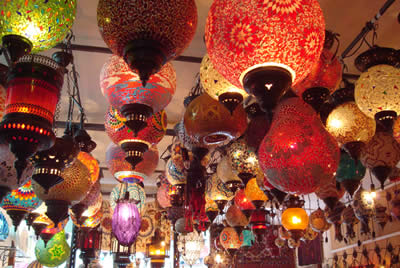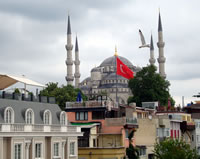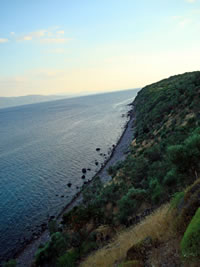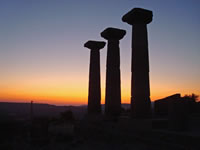 |  |  | |
News & Notices
News From:
Conference & Stage Expo
For the Record
 | A colorful experience awaits those who participate in the 2011 USITT Study Tour which will include more than two weeks in Turkey before heading for Prague and the opening of the Prague Quadrennial of Performance Design and Space. Tour leader for 2011 is Marianne Custer. Photos/Marianne Custer | |
| 2011 Study Tour to Focus On Turkish Theatres The USITT Study Tour will explore Turkey and its modern and ancient theatres from May 28 to June 14 before arriving in Prague for the opening of the 2011 Prague Quadrennial. The tour will start out in Istanbul, the former heart of the Ottoman Empire, a city that sprawls across two continents. Here participants will meet colleagues from the theatres of Istanbul and the University of Istanbul and gain insight into contemporary theatre practice in Turkey.
From Bursa, the tour will go to Assos on the Aegean coast, stopping along the way at the ruins of ancient Troy with its 4,000 years of history and a firm place in the human imagination. Celebrated in Homer’s Iliad and Odyssey and written of by the Roman poet Virgil, the place where the Trojan War was fought is now a UNESCO-listed archeological site.
From Assos, the tour heads south to Bergama. The town is best known in its former incarnation as Pergamon, the cultural center of a rich and powerful small kingdom during Greek and Roman times. Pergamon had a fine acropolis, the ruins of which survive today, including a 10,000-seat natural theatre and a Temple of Dionysus. There will be a stop in Izmir, the ancient city of Smyrna, for a possible visit to the State Theatre before proceeding to Selcuk, the gateway to Ephesus. Ephesus is one of the greatest archeological sites in the world and was founded by Ionian Greeks. Among its many remarkable ruins, is an amphitheatre which seated 44,000 people and is thought to have been the largest theatre in the ancient world. After two weeks of exploring Turkey, participants will say goodbye to their exotic adventure and fly to Prague for the opening of the 2011. Join this fascinating tour of a beautiful country where friendly faces, exotic locales, a delicious cuisine, and a sense of history unfolding are to be found. Those thinking of traveling are urged to add these books to a reading list to increased their understanding of the modern land and add to the allure of this Turkish adventure: Birds Without Wings by Louis Berniéres, Snow by Orhan Pamuk, Ataturk by Andrew Mango, and Portrait of a Turkish Family by Irfan Orga. Additional details and costs will appear in future Sightlines. | ||
United States Institute for Theatre Technology, Inc.: © 2010 Volume L, Number 1
 Visits are currently planned to the Municipal Theatre of Istanbul and the Rumeli Hisari, the historic Ottoman walled fortress on the banks of the Bosphorus where plays are performed in open air. The tour will include the Topkapi, the Ottoman Palace and its magnificent treasury, and the Museum of Turkish and Islamic Arts, built in 1520, housing massive traditional handmade carpets, ceramics, and a fascinating ethnographic collection. A cruise on the Bosphorus to the mouth of the Black Sea, strolling the Grand Bazaar, and enjoying the sights and scents of the Spice Bazaar are just a few of the many activities planned for this ancient city of mysteries.
Visits are currently planned to the Municipal Theatre of Istanbul and the Rumeli Hisari, the historic Ottoman walled fortress on the banks of the Bosphorus where plays are performed in open air. The tour will include the Topkapi, the Ottoman Palace and its magnificent treasury, and the Museum of Turkish and Islamic Arts, built in 1520, housing massive traditional handmade carpets, ceramics, and a fascinating ethnographic collection. A cruise on the Bosphorus to the mouth of the Black Sea, strolling the Grand Bazaar, and enjoying the sights and scents of the Spice Bazaar are just a few of the many activities planned for this ancient city of mysteries.  From Istanbul, the tour will travel to Bursa, the silk capital of Turkey and the center for Turkish shadow puppetry. Bursa was the first capital of the Ottoman Empire and is considered the birthplace of modern Turkey. It has innumerable ancient buildings, a museum of Ottoman folk costume and jewelry, and a bazaar with silk shops and shadow puppets.
From Istanbul, the tour will travel to Bursa, the silk capital of Turkey and the center for Turkish shadow puppetry. Bursa was the first capital of the Ottoman Empire and is considered the birthplace of modern Turkey. It has innumerable ancient buildings, a museum of Ottoman folk costume and jewelry, and a bazaar with silk shops and shadow puppets.  Also known as Behramkale, Assos was originally founded around 900 BC and included a Doric Temple to Athena on the hill above the town. Aristotle went there to teach in 348 BC, and St. Paul visited in 53 AD. An ancient Roman amphitheatre remains among Assos’ archeological excavations. The nearby village of Ayvaçik is home to the DOBAG project, which is focused on the traditional crafts of spinning, dyeing, and weaving of wool for Ayvacik rugs.
Also known as Behramkale, Assos was originally founded around 900 BC and included a Doric Temple to Athena on the hill above the town. Aristotle went there to teach in 348 BC, and St. Paul visited in 53 AD. An ancient Roman amphitheatre remains among Assos’ archeological excavations. The nearby village of Ayvaçik is home to the DOBAG project, which is focused on the traditional crafts of spinning, dyeing, and weaving of wool for Ayvacik rugs.